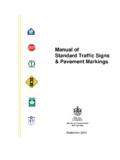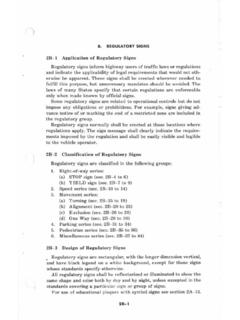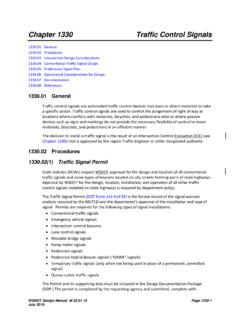Transcription of Turn Lane Warrants: Concepts, Standards, Application in …
1 1 turn Lane Warrants: Concepts, standards , Application in Review David J. DeBaie , 2004 ITE, District 1 Annual Meeting Burlington, Vermont Introduction Turning lanes at intersections reduce accidents (crashes) as crash rate comparisons in the ITE Traffic Engineering Handbook1 have demonstrated; yet, warrants or guidelines are not clearly established for a sufficiently broad range of conditions. Typically, state transportation departments review crash rates in determining the need for turn lanes and most review roadway volumes. States generally refer to American Association of State Highway Transportation Officials (AASHTO) for guidance on highway design2; however, most ITE District 1 states have adopted volume warrants or guidelines at unsignalized intersections that supplement the AASHTO guidance, which is partial for left turn lanes and absent for right turn lanes.
2 This turn lane warrant review focuses on unsignalized intersections, where there appears to be the greatest need. AASHTO s left turn guideline for left turns is examined in its effectiveness to convey the results of the 1967 research conducted by Harmelink3. Harmelink utilized a probabilistic model to establish left turn lane warrants for two-lane and four-lane highways at unsignalized T- intersections. AASHTO presents a summary table of points on Harmelink s graphed curves for two-lane highways. Interpretation of the table is difficult and many states have adopted forms of the graphs for two-lanes and remain consistent with AASHTO by excluding Harmelink s four-lane highway curves.
3 Volume based right turn lane warrants at unsignalized intersections are included in most state design manuals. The typical form is a graph for use on two-lane highways. Cottrell4 compiled existing research in 1981 and derived right turn lane design graphs for two-lane and four-lane highways. These graphs delineated warranting thresholds for multiple treatments: full turning lanes, a taper, and a radius. Alternatively, VTrans has developed a right turn lane protocol that is based on the Harmelink probability model. Several published research efforts and reports exhibit forms of the original Harmelink graphs.
4 These are cited in this review for several reasons: the work is more effective in conveying the warrant information; there is inconsistency with the original graphs (and with AASHTO); or there is contention with the Harmelink model on specific points. Other research (Agent5, Kikuchi and Chakroborty6) exists that proposes turn lane warrants based on accidents, delay, and level of service as alternate basis for warranting turning lanes; however, this review does not report on these concepts. 2 standards AASHTO standards are typically applied by most states where they are available.
5 These standards provide minimal guidance on turning lane warrants. There is repetition of Highway Capacity Manual7 advice at signalized intersections: at hourly volumes of 100 and 300 for left and right turn lanes respectively, auxiliary lanes should be considered. But different criteria apply to unsignalized intersections and AASHTO guidance is limited to left turn lanes on two-lane highways. AASHTO Exhibit 9-75 (shown as Figure 1) from the 2001 Greenbook summarizes left - turn lane warrant information from 16 of Harmelinks original graphs. AASHTO guidance is thereby provided for two-lane roadways with speeds between 40 and 60 mph, left - turn volume percentages between 5 and 30 percent, and total hourly volume in a single direction of 800 vehicles or less.
6 Maximum advancing volume without a left turn lane can be read from the AASHTO summary table given a known left turn percentage and the opposing volume. At 5 percent left turns opposed by 800 vehicles the maximum advancing volume without a left turn lane can be read from the table for three speeds: 330 vehicles per hour at 40 mph, 280 at 50 mph, and 230 at 60 mph. Minimum warranting left turn volumes within the AASHTO table are derived from the 5 percent left turn column. When opposed by 800 vehicles, the minimum suggested left turn volume requiring a left turn lane is: 17 left turns per hour at 40 mph, 14 at 50 mph, and 12 at 60mph.
7 Figure 1: ASSHTO Guide for left turn Lanes on Two-Lane Highways 3 Most states provide this information in a graphical form that summarizes Harmelink warrant thresholds by roadway speed. Curves for specific left turn percentages are shown. Each is like that shown for 40 mph in Figure 2. Figure 2: Typical State Design Manual Graph of left turn Lane warrant Conditions on Two-Lane Highways at 40 mph. 4 Most states include a graph in their design manuals for determining warranting volumes for right turn lanes at unsignalized intersections (Figure 3). This graph typically relates only to two-lane highways.
8 This graph of right turn volumes and total design hourly volume (DHV) presents a threshold line above which a right turn lane should be considered. The minimum hourly right turn volume where a right turn should be considered is 80 of 300 or 40 of 600 or more approach vehicles. Speed is not a factor except for a correction when posted speeds are below 45 mph (sometimes stated operating speed of 40 mph or design speed of 50 mph), the approach volume is less than 300 and right turns exceed 40. The correction reduces the right turn volume by 20 before entering the chart.
9 Figure 3: Typical State Design Manual Guideline for Right- turn Lanes at Unsignalized Intersections on Two-lane Highways 5 VTrans has adopted an alternate right turn lane volume warrant8, which is based on the Harmelink left turn warrant (Figure 4). A limited probability of a right turn vehicle delaying a through vehicle is set to derive a design chart with curves for speeds of 30-60 mph on two-lane highways and one curve for four-lane highways. When approach volumes are 800 vehicles per hour, the warranting right turn volumes range from 25 vehicles at 60 mph to 90 at 30 mph for two-lane roadways and 60 right turn vehicles on four-lane roadways.
10 Figure 4: VTrans right turn Auxiliary Lanes Traffic Volume Warrants 6 Concepts Harmelink s model for left turn warrants at unsignalized intersections is based on probability theory. A description of some of the parameters and an outline of the concept will provide the understanding needed to interpret the ASSHTO table or the original curves. As shown in Figure 5, the concept is based on the arrival of a vehicle on the advancing approach that queues behind a left turning vehicle that is waiting for a gap in the opposing approach flow. Figure 5: Harmelink s Arrival Event on a Two-lane Highway The arrival event on a two-lane highway involves a compound probability: first the probability of the presence of a left - turn vehicle, and second, the probability of the arrival of one or more through vehicles.






